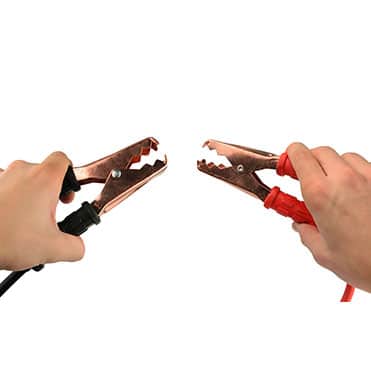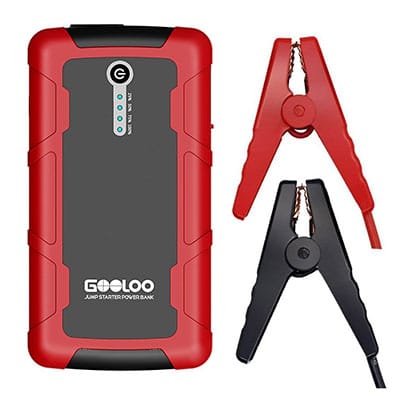Portable jump starters are like peace of mind in a box.
No waiting on AAA. No depending on seldom-used jumper cables in your trunk. No flagging down a passing motorist to give you a jump.
These cutting edge jumper packs are easy to use and safe. They’re also easy to store and maintain.
But you still need to choose the right one. The right size, the right features, and a unit you can trust when you need it to perform. Otherwise, you’re stuck with a false sense of security and a car that won’t start.
Below is everything you need to know about portable jump starters and how to choose the best one for you.

Size Of Portable Jump Starter You Need
When you think about a portable jump starter, what’s the first image that pops into your head?
Right – the traditional, heavy jump box. They’re still around and, in many circumstances, they’re the best jump starter your money can buy.
Yes, they’re heavy but getting lighter. Newer designs are sleeker and more efficient. Despite the weight, they’re still easy to carry and store in your trunk.
But if their size is a deal breaker, there’s an alternative.
Portable jump starters powered by lithium-ion batteries are quickly becoming a preferred alternative. These are hand-held units that come with carrying cases. They’re easily stored under your seat, in your center console, or in your glove box.
The compact size makes them great for new drivers, older drivers and those who can’t lift much weight.
But aren’t the compact jump packs less powerful than jump boxes? Not in the least.
The Power of Portable Jump Starters
Jump starter power is expressed either as cold cranking amps (CCA) or peak amps (PA). Measuring CCA tells you what to expect from your battery in the worst starting conditions imaginable. CCA is determined by putting a new, fully charged battery in a cold environment (0 degrees F) and measuring how many amps it discharges for 30 seconds. The higher the number, the more powerful the jump starter. But that doesn’t mean you should pick the jump pack with the highest CCA and call it good. There are two main factors to consider when deciding what power level is right for you.
Engine Size
A compact or small sedan battery can be jumped with as little as 150 CCA. Full-size trucks and SUV’s need around 450 CCA. Engine size is important but age is part of the equation, as well.Vehicle Age
Assuming similar sized vehicles, the older the vehicle the more amps are needed to jump it. For example, a 20-year-old, 8 cylinder engine pickup needs more amps to start than a brand new one. This is due to improvements in engine design and newer starter motors. As a general rule, 400-500 CCA should start most any passenger vehicle on the road. Remember, your car isn’t the only one you may be jump starting. Choose a portable jump starter that allows you to help a fellow motorist in need too.
Flashlight
A flashlight is a common feature found in both the larger and smaller portable jump starters. They come in handy when you need a jump at night or find yourself stranded for some other reason. Look for one with high lumens. The last item in our guide is the warranty. We’ve combined this section with customer service because what good is a warranty if you can’t reach the manufacturer to make a claim?Safety First
These are batteries were talking about and batteries contain electricity. Electricity is dangerous when not handled correctly. The risk of injury, damage to your battery or jump starter, and fire is ever present. It’s a good thing portable jump starters have several built in safety features.
- Short Circuit Protection – prevents high current from passing from positive to negative clamps when accidentally touched together
- Over-current Protection – prevents damage to the jump starter by keeping it from supplying more current than it’s peak limit
- Overload Protection – keeps the jump pack from receiving more current than the manufacturer’s specifications when being charged
- Over-voltage Protection – keeps the jump pack from receiving more voltage than manufacturer’s specifications when being charged
- Overcharge Protection – when the jump starter’s batteries are full, this will “float” charge the unit and keep excess voltage from being applied to the cells

Reliability Of The Jump Starter
Many people think a higher price means higher quality but that’s not always the case. There are specific things to look for in each portable jump starter. These will help you determine how long a jump pack will perform at its best.
Capacity
Capacity is how many times can you jump start your car before having to recharge the jump starter. Units as small as 6000 mAh offer enough capacity for a handful of starts.
The good thing is all reputable manufacturers build plenty of capacity into their units for a handful of starts. Don’t get caught up with capacity. Almost every jump starter you consider will have more than enough.
Cold Weather Capability
If you live in a warm climate year-round and aren’t planning any drives to Minnesota, this will not be a concern. But if you live where the winters are harsh, choose a jump starter that can stand the cold.
Your car battery can lose up to 50% of its cranking output in cold weather. This means you should expect that same loss of performance in a traditional jump box. While lithium-ion jump packs perform better, they still lose some power in the cold too.
The best portable jump starters, when operated at room temperature, can jump a frozen battery. It’s also a good idea to buy a jump starter with higher CCA if you live in a cold climate.
Build Quality and Design
Here’s a great example of how price doesn’t always mean top quality. It’s possible to buy an otherwise quality jump pack with cheap clamps that won’t last and don’t conduct very well.
Look for clamps that are soldered or screwed to the cables versus crimped. Clamps should also open wide enough to fit any size terminal post without any bending or twisting.
On the smaller jump packs, the cables are a separate component that plugs into the main jump unit. Some designs have the plug coming directly out of a circuitry box. These can be hard to handle and rest in the engine compartment. The best-designed models place some cable in between the plug and the box, making for easier handling.
Finally, it’s important to keep water and other contaminants out of connection ports, to help the unit last for a long time. This means the jumper cable connection port is usually covered because of its size. At a minimum, look for covers that seal tightly. Even better are ones that cover all ports, as well.
Design and material quality go hand in hand with features and accessories so let’s take a look at add-ons that may interest you.
Features and Accessories In Portable Jump Starter
The type of accessories will differ greatly between traditional jump boxes and their smaller lithium-ion counterparts. Here are examples of the more common accessories found on each.
USB Charging
This feature is mostly found on the small lithium-ion units but does come on a few of the larger jump boxes. Be sure to look at product reviews to see how well this features works, according to those who have tested it.Multiple Power/Charging Outlets
Some of the larger jump boxes also have multiple power outlets built in, like traditional electrical outlets and 12-volt charger plugs. Versatility is the main factor in having these power sources. As well as jump starting your car, you can use your jump box for tailgating or camping. Some lithium-ion jump starters have specialty ports, like 19V for laptop charging or 12V for accessories like fans, heated blankets, or lanterns.Air Compressor
When your TPMS light comes on and you’re not near a gas station, it’s good to know your jump box has a built-in compressor. That is if your jump box does have a built-in compressor. This is a common feature on larger portable jump starters and well worth having if you don’t live close to a gas station or don’t like feeding quarters to the air machine.Warranty
The gold standard for portable jump starters is a one year warranty. Be wary of manufacturers offering less.
Speaking of manufacturers, be sure your unit is made by a reputable company in the auto or consumer electronics industry. They should also be easily reachable by phone or email and have accessible support information, preferably on the web.

The Last Word On The Best Poratble Jump Starters
Portable jump starters come in many shapes and sizes, with features galore. Power, safety, design, and reliability are all important factors in making the right choice. When deciding which one is best for you, focus on the points we’ve covered and you won’t go wrong.
Check out our best portable jump starter reviews for information on specific models.










